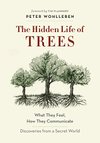The Hidden Life of Trees: What They Feel, How They Communicate—Discoveries from A Secret World (The Mysteries of Nature Book 1)
amazon.com
Saved by maddispatch and
The Hidden Life of Trees: What They Feel, How They Communicate—Discoveries from A Secret World (The Mysteries of Nature Book 1)

Saved by maddispatch and
forests are superorganisms with interconnections much like ant colonies.
Blossoms do not release scent at random or to please us.
Wherever it hurts, that’s where the tree must strengthen its support structure.
modern forestry targets a maximum age of 80 to 120 years before plantation trees are cut down and turned into cash. Under natural conditions, trees that age are no thicker than a pencil and no taller than a person. Thanks to slow growth, their inner woody cells are tiny and contain almost no air. That makes the trees flexible and resistant to
... See morewhen trees are really thirsty, they begin to scream. If you’re out in the forest, you won’t be able to hear them, because this all takes place at ultrasonic levels. Scientists at the Swiss Federal Institute for Forest, Snow, and Landscape Research recorded the sounds, and this is how they explain them: Vibrations occur in the trunk when the flow of
... See moresliding extremely slowly down to the valley over the course of many years, often at a rate of no more than an inch or two a year. When this happens, the trees slip slowly along with the ground and tilt over while they continue to grow vertically. You can see extreme cases of this in Alaska and Siberia, where climate change is causing the permafrost
... See moreIn the case of a mature beech, the tree exhales hundreds of gallons of water a day. This exhalation causes suction, which pulls a constant supply of water up through the transportation pathways in the tree. Suction works as long as the columns of water are continuous. Bonding forces cause the water molecules to adhere to each other, and because
... See moreit makes its way up around the little trunks, always twining in a clockwise direction.
Diversity provides security for ancient forests. Because fungi are also very dependent on stable conditions, they support other species underground and protect them from complete collapse to ensure that one species of tree doesn’t manage to dominate.